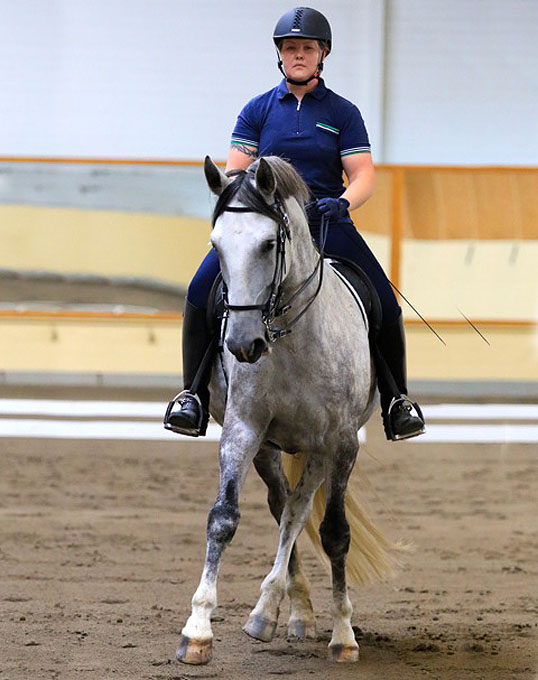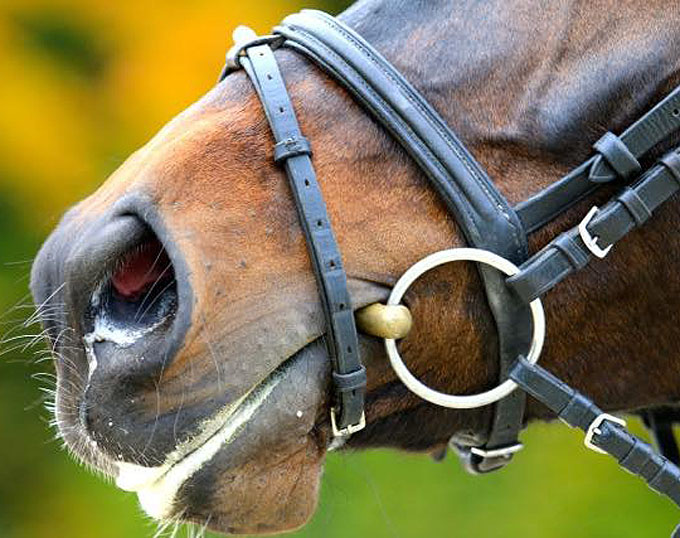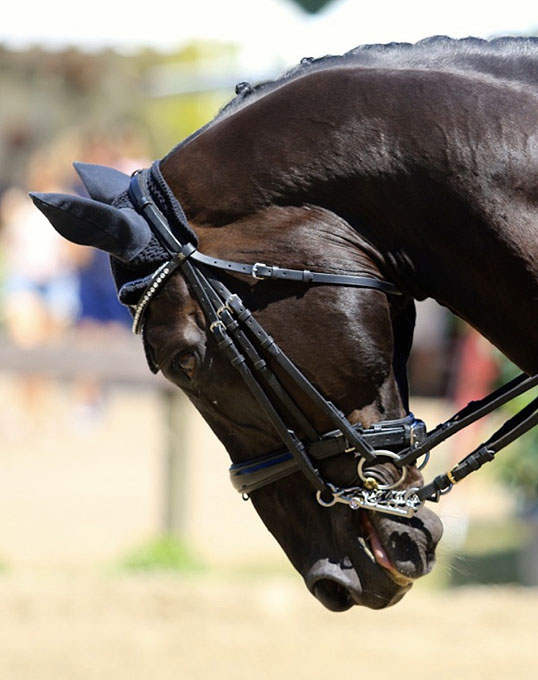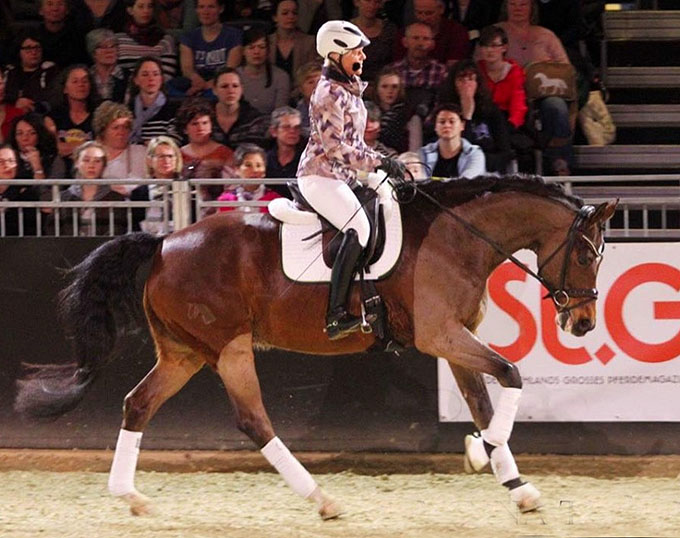
Balance is prerequisite for good riding. Without proper balance it is not possible to create correct collection or a harmonious healthy movement. Balance is built of many different ingredients and from riding point of view one of the key issues is how the frame and rein contact allow the horse to use its body.
For balanced and dynamic movement the horse needs to be able to move in a soft, supple and relaxed frame that is easily variable, because whenever we change the frame, the balance is challenged. It must remain high on our priority list to take care of the best possible balance through the levels and our daily work. One important skill is to be able to change the frame easily, so that the horse remains in a soft, light and comfortable contact through the different frames and exercises. This kind of contact is in turn a precondition for a horse able to move in balance and change his frame easily.
This means the horse needs to know how to follow the bit easily. You can test this by allowing the horse to stretch forwards downwards and then ask the horse to lift the head again back to normal frame, remaining slightly in front of the vertical while doing this. You also need to be able to use lateral flexions and bend the horse through its neck and the body. Any resistance in following these requests is a risk for the quality of the movement, and constant pressure on rein should not be accepted. Is this the case, it is necessary to return back to the basics and work on the good soft contact before going on in a horse’s training.
To sum up: The neck of the horse needs to function easily in all directions you ask the horse to bend, but be careful not to overbend the neck as this results in restrictions in the whole body, causing compensations and difficulties to move with ease through the body, so the balance will be negatively and sometimes severely affected.
Balance and Vestibular System

but moves in lateral work with a correct lateral
flexion and bend.
When ridden, does the horse keep ears level when he is turning or is he suggesting to turn one ear lower than the other, probably even pushing against one rein? This kind of rotation of the neck is often seen when the horse is asked to bend or give a lateral flexion, for example during lateral work. (Photo 2: Niina and grey Lusitano in trot half-pass)
If this is the case, it would be good to address if there is tension in neck or back musculature, or if there is something in the mouth that would need to be checked by a veterinarian. The equipment should be checked to see if something might be related to the problem. The rider may of course have a part in this too, but sometimes even stable routines are lying behind some problems.
With this in mind, it might therefore be useful to think about the daily routines in the stable environment - are there situations where horse seeks and keeps a position repeatedly, or for a longer time, like eating from a hay net always in certain crooked posture?
Balance and Temporomandibular Joint

so fit the noseband properly and do not tighten it.
The tongue is connected to the jaw via the hyoid bones, which are attached to the skull on the medial side of TMJ. The tongue is very sensitive and important for the balance also because of its soft tissue connections. It needs to be able to rest and function comfortably in the mouth even when the horse is ridden. Any resistance on the tongue will result in tension in jaw, neck and therefore directly on the shoulder area, reflecting the tension towards thoracic and trunk areas via muscle and fascial connections. If the tongue is not able to function freely, it will also cause difficulties in swallowing and breathing. (From human research we even known, that a relaxed tongue position has a surprisingly significant effect on muscle power.)
Balance and Vision
Vision is a very important part of the puzzle that is balance, and here the frame really matters. Vision communicates with the brain and the vestibular system and the frame affects how tension is created in the body, but it also can restrict or allow the horse to see what is happening around it. For a prey animal like a horse, it is very important to be able to use his vision. If this is not possible, it will affect his balance on a physical level because it gets more difficult to sense where the steps are landing. But this also has big effect on a mental level. If you cant see where you are stepping, you are not moving comfortably. This will affect the mental aspect of exercise, which will immediately lead to problems in physical balance as well. To move well and really use the proprioception possibilities of the body, we need to be able to move as easily as possible, both mentally and physically and it is exactly the same for the horse!

move comfortably. It’s even more important
for a horse as he is a prey animal.
Balance and Correct Stretch
Changing the frame challenges the balance. A forward downward stretch can be done in different ways, and if the horse is facing problems in balancing himself (for example falling ont the shoulders) it is good to start with a smaller amount of stretch, and at same time give him an idea of the direction with the rein. If we just offer the hand directly forward-downward, it will help the horse reach forward, but to create an easier balance, we should create a certain kind of feeling for the horse of giving on the bit to get an even more precise answer from the horse. If the contact is offered using a round, giving and slightly lifting touch, the horse will feel carrying the base of the neck more easily. You can try this with your friend: Ask her to take a bridle in one hand and hold the bit with another while you are holding the reins normally. If you just give forward with the hand or if you direct the request a little up and forward, softly in a rounded way, still keeping a soft contact, both will cause very different feelings in the bit. The latter action creates a softer feeling than just giving the hand forward and down and it progressively shows the horse the way.
To initiate the stretch start with the hands in a normal position and the horse in a good, natural frame. Then offer your hands slightly forward and at the same time lift them gently upwards and towards the horses ears, then directing downwards. Keep your fingers, arms and shoulders relaxed, and allow the hand to get back to its normal position after the horse has followed your request. Remember that while you direct the rein a little upwards, no pressure is added, just keep the soft contact, while allowing the horse to open the frame slightly forward.

keeps his balance. Here Uta Gräf and Feeling Good H
during a display at Equitana 2017
It is also important that with a young or inexperienced or a correction horse you do it just a little at first, so that the balance can be remained, but the horse still gets the idea of searching forward into the contact. This also teaches the horse quite quickly to follow the hand, at first it is enough that the rider gets a feeling that the horse is about to follow the hand to any useful direction. After a few repetitions it will be easier to add some more stretching into the movement, without the horse pulling downwards or falling onto his shoulders. Make sure that the horse is moving forward in a good balance, and with enough energy. It is easiest to start this with most horses at first in trot, but should then be done easily in all gaits as soon as the horse has learnt to follow the hand in all directions.
Only when horse remains relaxed in the mouth while changing the frame, it is easier and useful to start refining other exercises.
Text by Niina Kirjorinne
Photos by Minna Tallberg, Silke Rottermann
Related Links
Functionality in Equitation: Aim for Good Movement
Functionality in Equitation: Fascia and Movement
Functionality in Equitation: Fascia Treament - Surface Has a Deep Effect
Meet Niina Kirjorinne, Classical Dressage Rider and Physiotherapist
Effect of Noseband Positioning to Fascial and Neural Dynamics of the Head